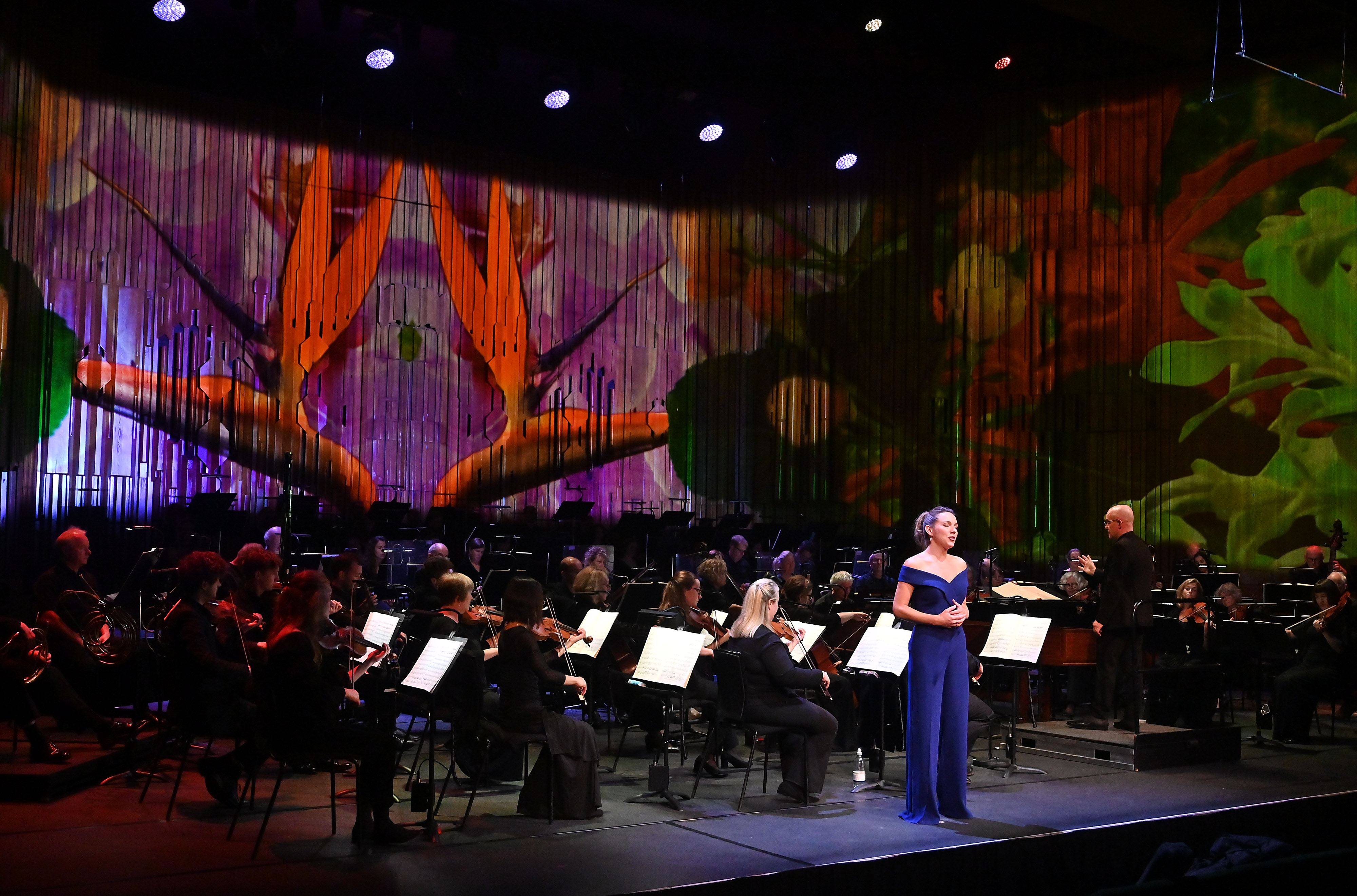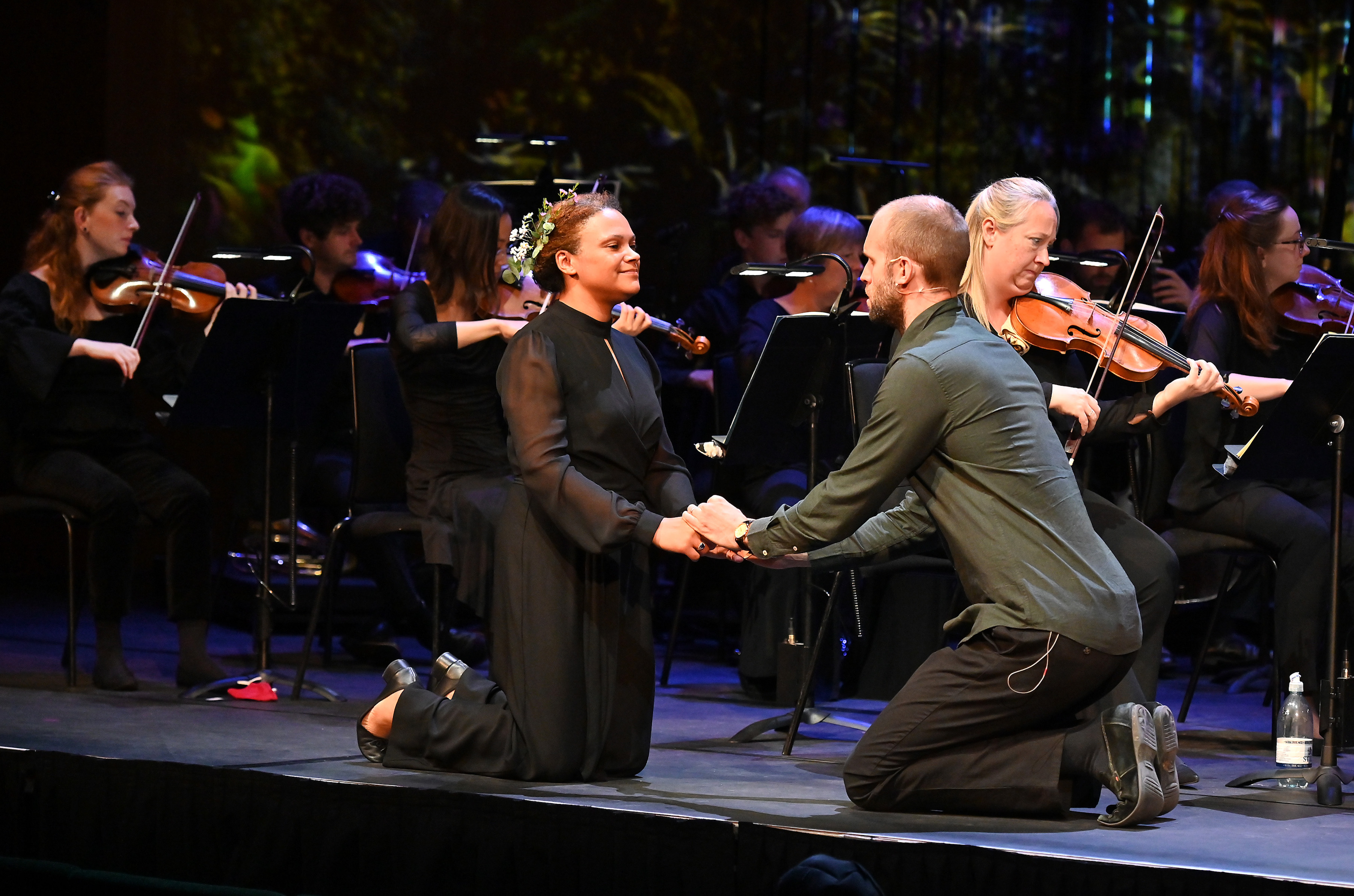The Creation, Academy of Ancient Music, Cummings, Barbican review - back to choral paradise | reviews, news & interviews
The Creation, Academy of Ancient Music, Cummings, Barbican review - back to choral paradise
The Creation, Academy of Ancient Music, Cummings, Barbican review - back to choral paradise
A joyful and lavish rebirth for Haydn's happy masterpiece
Whatever the upsets and uncertainties of this musical season, the return of choral works at full scale and full power has been an unalloyed joy. And sheer, exhilarated, heaven-storming joy branded the Academy of Ancient Music’s reading of Haydn’s The Creation in the Barbican Hall on Tuesday night.
This Creation came into being in English rather than German. The libretto, after all, was published bilingually in the first edition of 1800. Throughout the piece you can hear Haydn striving – and even managing – to best the musical coups he had admired in Handel’s English-language oratorios in London. On top of his first-class players and chorus, and the accomplished solo voices, Cummings had extra help on the way to paradise in the form of the video projections by Nina Dunn Studio. They surrounded the stage in an ever-changing swirl of digital effects. All that virtuoso hi-tech wallpaper – video-designed by Matt Brown – introduced a risk of sensory overload in a work already full of mimetic and descriptive writing that gives a musical colouring to every kind of entity from worms to flowers to stars. 
As for the three angelic soloists in the first two parts, they avoided oratorio stiffness by a measure of mobility. They flung their recitatives from the back of the stage but moved forward to the front for their arias. Stuart Jackson’s Uriel made a genial, urbane but formidable tenor linchpin, mighty but never rough in the flowing lines of his narration. This voice is an absolute rock, but a friendly rather than jagged one. When the sun first rose in its aural and (in this production) visual glory, he more than held his own. Matthew Brook’s Raphael captured the curious mix of lyricism, wonder and drollery in Haydn’s settings of the Genesis stories. His soaring, rhapsodic passages of awe yield to stretches of almost-comic patter as the sheer oddity of God’s handiwork – slitherers, waddlers, creepy-crawlies and all – finds musical shape. It’s not often you hear audience belly-laughs in a canonical masterpiece like this, but Brook got them when he showed how “in long dimension creeps with sinuous trace the worm”. 
Cummings broke for the interval there, and so left the scenes of Adam and Eve in the garden of Eden to follow as a shorter, self-contained coda. Rather than have the angelic soprano and bass soloists return, as usual, the AAM had the luxury of fresh voices as the blessed pair: Rachel Redmond and Ashley Riches, both mellow in their tone, precise in their diction and fully attuned to the gorgeous ebb and flow of their joint numbers. As Haydn’s music changes perspective from divine to human love, the universal to the intimate, the solitary eminence of the angels gives place to quasi-operatic drama. So these ancestors of humanity touched, embraced, kneeled and even lay down on their paradisal floor. 
rating
Explore topics
Share this article
The future of Arts Journalism
You can stop theartsdesk.com closing!
We urgently need financing to survive. Our fundraising drive has thus far raised £49,000 but we need to reach £100,000 or we will be forced to close. Please contribute here: https://gofund.me/c3f6033d
And if you can forward this information to anyone who might assist, we’d be grateful.

Subscribe to theartsdesk.com
Thank you for continuing to read our work on theartsdesk.com. For unlimited access to every article in its entirety, including our archive of more than 15,000 pieces, we're asking for £5 per month or £40 per year. We feel it's a very good deal, and hope you do too.
To take a subscription now simply click here.
And if you're looking for that extra gift for a friend or family member, why not treat them to a theartsdesk.com gift subscription?
more Classical music
 BBC Proms: A Mass of Life, BBCSO, Elder review - a subtle guide to Delius's Nietzschean masterpiece
Mark Elder held back from blasting the audience with a wall of sound
BBC Proms: A Mass of Life, BBCSO, Elder review - a subtle guide to Delius's Nietzschean masterpiece
Mark Elder held back from blasting the audience with a wall of sound
 BBC Proms: Le Concert Spirituel, Niquet review - super-sized polyphonic rarities
Monumental works don't quite make for monumental sounds in the Royal Albert Hall
BBC Proms: Le Concert Spirituel, Niquet review - super-sized polyphonic rarities
Monumental works don't quite make for monumental sounds in the Royal Albert Hall
 Frang, Romaniw, Liverman, LSO, Pappano, Edinburgh International Festival 2025 review - sunlight, salt spray, Sea Symphony
Full force of the midday sea in the Usher Hall, thanks to the best captain at the helm
Frang, Romaniw, Liverman, LSO, Pappano, Edinburgh International Festival 2025 review - sunlight, salt spray, Sea Symphony
Full force of the midday sea in the Usher Hall, thanks to the best captain at the helm
 Elschenbroich, Grynyuk / Fibonacci Quartet, Edinburgh International Festival 2025 review - mahogany Brahms and explosive Janáček
String partnerships demonstrate brilliant listening as well as first rate playing
Elschenbroich, Grynyuk / Fibonacci Quartet, Edinburgh International Festival 2025 review - mahogany Brahms and explosive Janáček
String partnerships demonstrate brilliant listening as well as first rate playing
 BBC Proms: Akhmetshina, LPO, Gardner review - liquid luxuries
First-class service on an ocean-going programme
BBC Proms: Akhmetshina, LPO, Gardner review - liquid luxuries
First-class service on an ocean-going programme
 Budapest Festival Orchestra, Iván Fischer, Edinburgh International Festival 2025 review - mania and menuets
The Hungarians bring dance music to Edinburgh, but Fischer’s pastiche falls flat
Budapest Festival Orchestra, Iván Fischer, Edinburgh International Festival 2025 review - mania and menuets
The Hungarians bring dance music to Edinburgh, but Fischer’s pastiche falls flat
 Classical CDs: Hamlet, harps and haiku
Epic romantic symphonies, unaccompanied choral music and a bold string quartet's response to rising sea levels
Classical CDs: Hamlet, harps and haiku
Epic romantic symphonies, unaccompanied choral music and a bold string quartet's response to rising sea levels
 Kolesnikov, Tsoy / Liu, NCPA Orchestra, Chung, Edinburgh International Festival 2025 review - transfigured playing and heavenly desire
Three star pianists work wonders, and an orchestra dazzles, at least on the surface
Kolesnikov, Tsoy / Liu, NCPA Orchestra, Chung, Edinburgh International Festival 2025 review - transfigured playing and heavenly desire
Three star pianists work wonders, and an orchestra dazzles, at least on the surface
 BBC Proms: Láng, Cser, Budapest Festival Orchestra, Iván Fischer review - idiomatic inflections
Bartók’s heart of darkness follows Beethoven’s dancing light
BBC Proms: Láng, Cser, Budapest Festival Orchestra, Iván Fischer review - idiomatic inflections
Bartók’s heart of darkness follows Beethoven’s dancing light
 Weilerstein, NYO2, Payare / Dueñas, Malofeev, Edinburgh International Festival 2025 review - youthful energy and emotional intensity
Big-boned Prokofiev and Shostakovich, cacophonous López, plus intense violin/piano duo
Weilerstein, NYO2, Payare / Dueñas, Malofeev, Edinburgh International Festival 2025 review - youthful energy and emotional intensity
Big-boned Prokofiev and Shostakovich, cacophonous López, plus intense violin/piano duo
 theartsdesk at the Three Choirs Festival - Passion in the Cathedral
Cantatas new and old, slate quarries to Calvary
theartsdesk at the Three Choirs Festival - Passion in the Cathedral
Cantatas new and old, slate quarries to Calvary

Add comment